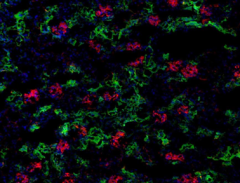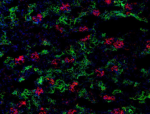- Clone
- RME-1/CD62E (See other available formats)
- Regulatory Status
- RUO
- Other Names
- E-selectin, ELAM-1, LECAM-1
- Isotype
- Mouse IgG1, κ

-

C57BL/6 mouse frozen kidney section was fixed with 4% paraformaldehyde (PFA) for 10 minutes at room temperature and blocked with 5% FBS for 30 minutes at room temperature. Then the section was stained with 5 µg/ml of purified anti-mouse CD62E (clone RME-1/CD62E) overnight at 4°C followed by 2.5µg of anti-mouse IgG Alexa Fluor® 488 (red) and Alexa Fluor® 594 anti-mouse CD326/Ep-CAM (clone G8.8) antibody (green) for 2 hours at room temper -

Mouse brain endothelial cell line bEND.3 cells were stimulated with TNF-α overnight. Then the cells were fixed with 1% paraformaldehyde (PFA) for 10 minutes and blocked with 5% FBS for 30 minutes, subsequently stained with 5 µg/ml of purified anti-mouse/rat CD62E (clone RME-1/CD62E) (red) in blocking buffer for 3 hours at room temperature followed by DyLight™ 594 Goat anti-mouse IgG for another 2 hours at room temperature. Nuclei were counterstained with DAPI (blue). The image was captured with 40X objective.
| Cat # | Size | Price | Quantity Check Availability | ||
|---|---|---|---|---|---|
| 148801 | 50 µg | $89.00 | |||
| 148802 | 500 µg | $323.00 | |||
CD62E (also known as E-selectin, ELAM-1, and LECAM-1) is a 115 kD type I transmembrane protein and a member of the selectin family. CD62E is highly expressed on activated endothelial cells. CD62E is involved in leukocyte tethering and rolling on activated endothelium at inflammatory sites and may also play a role in tumor metastasis and angiogenesis. CD62E binds to both Sialyl Lewis X (CD15s) and PSGL-1 (CD162).
Product Details
- Verified Reactivity
- Mouse, Rat
- Antibody Type
- Monoclonal
- Host Species
- Mouse
- Immunogen
- Rat E-selectin transfected chinese hamster ovary cells
- Formulation
- Phosphate-buffered solution, pH 7.2, containing 0.09% sodium azide.
- Preparation
- The antibody was purified by affinity chromatography.
- Concentration
- 0.5 mg/mL
- Storage & Handling
- The antibody solution should be stored undiluted between 2°C and 8°C.
- Application
-
IHC-F - Quality tested
ICC - Verified
WB, IP, ELISA, Block - Reported in the literature, not verified in house - Recommended Usage
-
Each lot of this antibody is quality control tested by immunohistochemical staining on frozen tissue sections. For immunohistochemistry, a concentration range of 2.5 - 5.0 µg/mL is suggested. For immunocytochemistry, a concentration range of 5.0 - 10 μg/mL is recommended. It is recommended that the reagent be titrated for optimal performance for each application.
- Application Notes
-
Additional reported applications (for the relevant formats) include: immunohistochemical staining of frozen tissue sections4,5, Western blotting1, immunoprecipitation1, ELISA7, and blocking1,2,3. For in vivo studies or highly sensitive assays, we recommend Ultra-LEAF™ purified antibody (Cat. No. 148803).
-
Application References
(PubMed link indicates BioLegend citation) -
- Walter UM, et al. 1997. Hybridoma 16:249. (Block, WB, IP)
- Walter UM, et al. 1997. Immunology 92:290. (Block, Rat Reactivity)
- Hickey MJ, et al. 1998. Circ. Res. 83:1124. (Block, Mouse Reactivity)
- Bernardes-Silva M, et al. 2001. J. Cereb. Blood Flow Metab. 21:1115. (IHC)
- Alvarez A, et al. 2004. Blood 104:402. (IHC, Rat Reactivity)
- Piccio L, et al. 2002. J. Immunol. 168:1940. (IF)
- Walter UM, et al. 1997. in Hybridoma 16:355. (ELISA)
- Product Citations
-
- RRID
-
AB_2564222 (BioLegend Cat. No. 148801)
AB_2564222 (BioLegend Cat. No. 148802)
Antigen Details
- Structure
- Member of the selectin family, 115 kD type I membrane protein; contains one C-type lectin domain and one EGF-like domain
- Distribution
-
Highly expressed on activated endothelial cells
- Function
- Involved in leukocyte tethering and rolling on activated endothelium at inflammatory sites, may also play a role in tumor metastasis and angiogenesis
- Ligand/Receptor
- Sialyl Lewis X (CD15s) and PSGL-1 (CD162) bind to CD62E. Recently, CLA (cutaneous lymphocyte antigen) has also been reported to interact with CD62E
- Cell Type
- Endothelial cells
- Biology Area
- Cell Adhesion, Cell Biology, Immunology, Innate Immunity, Neuroscience, Neuroscience Cell Markers
- Molecular Family
- Adhesion Molecules, CD Molecules
- Antigen References
-
- Collins T, et al. 1991. J. Biol. Chem. 266:2466
- Bevilacqua MP, et al. 1987. Proc. Natl. Acad. Sci. USA 84:9238
- Berg EL, et al. 1991. J. Exp. Med. 174:1461.
- Lawrence MB, et al. 1993. J. Immunol. 151:6338.
- Walz G, et al. 1990. Science 250:1132
- Gene ID
- 20351 View all products for this Gene ID
- UniProt
- View information about CD62E on UniProt.org
Other Formats
View All CD62E Reagents Request Custom Conjugation| Description | Clone | Applications |
|---|---|---|
| Purified anti-mouse/rat CD62E (E-selectin) | RME-1/CD62E | IHC-F,ICC,WB,IP,ELISA,Block |
| Ultra-LEAF™ Purified anti-mouse/rat CD62E (E-selectin) | RME-1/CD62E | IHC-F,ICC,WB,IP,ELISA,Block |
Compare Data Across All Formats
This data display is provided for general comparisons between formats.
Your actual data may vary due to variations in samples, target cells, instruments and their settings, staining conditions, and other factors.
If you need assistance with selecting the best format contact our expert technical support team.
-
Purified anti-mouse/rat CD62E (E-selectin)

C57BL/6 mouse frozen kidney section was fixed with 4% parafo... 
Mouse brain endothelial cell line bEND.3 cells were... -
Ultra-LEAF™ Purified anti-mouse/rat CD62E (E-selectin)

Mouse brain endothelial cell line bEND.3 cells were stimulat...
